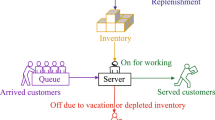Abstract
The model of perishable queueing-inventory system with server vacations is studied. Upon service completion, server takes vacation if there are no customers in the queue and it starts service at the end of the vacation if the number of customers in the system exceeds some threshold; otherwise, it takes new vacation. Exact and approximate methods are proposed to calculate the characteristics of the system.
Similar content being viewed by others
References
V. S. Koroliuk, A. Z. Melikov, L. A. Ponomarenko, and A. M. Rustamov, “Asymptotic analysis of the system with server vacation and perishable inventory,” Cybern. Syst. Analysis, Vol. 53, No. 4, 543–553 (2017).
J. G. Kemeny and J. L. Snell, Finite Markov Chains, Princeton University Press, Princeton (1960).
G. Guardabassi and S. Rinaldi, “The problems in Markov chains: A topological approach,” Operations Research, Vol. 18, Issue 2, 324–333 (1970).
B. N. Feinberg and S. S. Chiu, “A method to calculate steady-state distributions of large Markov chains by aggregating states,” Operations Research, Vol. 35, Issue 2, 282–290 (1987).
D. S. Kim and R. L. Smith, “An exact aggregation/disaggregation algorithm for large scale Markov chain,” Naval Research Logistics, Vol. 42, No. 7, 1115–1128 (1995).
P. J. Courtois, Decomposability: Queueing and Computer System Applications, Academic Press, New York–London–San Francisco (1977).
J. R. Koury, D. F. McAllister, and W. J. Stewart, “Iterative methods for computing stationary distribution of nearly completely decomposable Markov chains,” SIAM J. on Algebraic and Discrete Methods, Vol. 5, No. 2, 164–186 (1984).
M. Haviv, “Aggregation/disaggregation methods for computing the stationary distributions of a Markov chain,” SIAM J. on Numerical Analysis, Vol. 24, No. 4, 952–966 (1987).
W. J. Stewart, Introduction to the Numerical Solution of Markov Chains, Princeton University Press, Princeton (1994).
D. F. Rogers and R. Plante, “Estimating equilibrium probabilities for band diagonal Markov chains using aggregation and disaggregation techniques,” Computers & Operations Research, Vol. 20, No. 8, 857–877 (1993).
P. O. Dianne, Iterative Methods for Finding the Stationary Vector for Markov Chain, IMA Preprint Series, No. 932 (1992).
U. Sumita and M. Rieders, “Application of the replacement process approach for computing the ergodic probability vector of large scale row-continuous Markov chains,” J. of the Operations Research Society of Japan, Vol. 33, No. 4, 279–307 (1990).
V. S. Koroliuk and A. F. Turbin, Semi-Markov Processes and Their Applications [in Russian], Naukova Dumka, Kyiv (1976).
L. Ponomarenko, C. S. Kim, and A. Melikov, Performance Analysis and Optimization of Multi-Traffic on Communication Networks, Springer, Berlin–Heidelberg (2010).
A. Melikov and L. Ponomarenko, Multi-Dimensional Queueing Models in Telecommunication Networks, Springer, Heidelberg (2014).
C. Liang and H. Luh, “Optimal services for content delivery based on business priority,” J. of the Chinese Institute of Engineers, Vol. 36, No. 4, 422–440 (2013).
C. Liang and H. Luh, “Efficient method for solving a two-dimensional Markov chain model for call centers,” Industrial Management & Data Systems, Vol. 115, No. 5, 901–922 (2015).
M. E. Haddad and F. Belarbi, “Approximate analysis of an unreliableM / M /c retrial queue with phase merging algorithm,” New Trends in Mathematical Sciences, Vol. 4, No. 3, 9–21 (2016).
B. Jajaraman, B. Sivakumar, and G. Arivarignan, “A perishable inventory system with postponed demands and multiple server vacations,” in: Modeling and Simulation in Engineering, Hindawi Publishing Corporation, Vol. 2012, Article ID 620960.
A. Z. Melikov, L. A. Ponomarenko, and S. A. Bagirova, “Markov models of queueing-inventory systems with variable order size,” Cybern. Syst. Analysis, Vol. 53, No. 3, 373–386 (2017).
Author information
Authors and Affiliations
Corresponding author
Additional information
Translated from Kibernetika i Sistemnyi Analiz, No. 1, January–February, 2018, pp. 35–50
Rights and permissions
About this article
Cite this article
Koroliuk, V.S., Melikov, A.Z., Ponomarenko, L.A. et al. Models of Perishable Queueing-Inventory Systems with Server Vacations. Cybern Syst Anal 54, 31–44 (2018). https://doi.org/10.1007/s10559-018-0005-4
Received:
Published:
Issue Date:
DOI: https://doi.org/10.1007/s10559-018-0005-4



